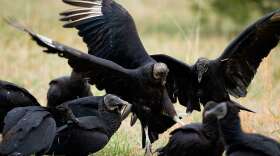Two cattle mutilation cases in McPherson and Harvey counties have law enforcement officials still searching for answers – even delving into cases from more than 40 years ago.
So far, there have been no leads in the cases, which includes a bull found dead in Harvey County Dec. 18, with its genitalia removed, followed by a Jan. 1 case near Canton in which a pregnant cow was found dead with its eye harvested.
Harvey County Sheriff T. Walton said he received the toxicology report on the bull Friday. Iowa State University tested for 20,000 compounds and came up with nothing.{p dir=”ltr”}The bull wasn’t old, Walton said. He added the genitals weren’t removed by animals or coyotes but were cut off.
Meanwhile, McPherson County rancher John Shearer said the veterinarian doing the necropsy on his cow reported that it was indeed cut out with a laser. He is awaiting a toxicology report as well.
Walton said he continues to investigate, searching out information from law enforcement across Kansas. That includes one former Butler County officer who was part of the 1970s investigation. Walton said Butler County worked 30 or 40 cases during the decade.{p dir=”ltr”}“I have no idea why anyone would do that,” he said of mutilating livestock.
Moreover, they couldn’t find any tire tracks or other evidence. Both cases happened in pastures off the beaten path.
The Harvey County bull is valued at $4,000, Walton said
Shearer has said that, in all, the net loss of the cow and unborn calf is around $20,000 to $30,000. Shearer is offering a $5,000 reward for tips leading to an arrest in his case. Kansas Farm Bureau, along with its county affiliates in Harvey and McPherson, is offering a $3,000 reward in both cases.
Walton said two years ago, three bulls near Inman were found with their sex organs removed. Other cases were discovered in the Kansas City area in 2012.
Meanwhile, an animal was found mutilated near Hillsboro in the 1980s.
Charlie Lee, K-State Extension wildlife specialist, said he has investigated several cases over the years, including one just a year ago discovered near Hill City.
He noted predators can make cuts that are unusual and odd shaped, but those experienced can determine such markings. Predators also like to attack softer tissue first.
He noted often in predator attacks, investigators will find foot tracks or scat, evidence of feeding.
In many cases, that evidence isn’t present, including the case near Hill City.
But what causes it? He doesn’t theorize.
“My conclusion: It is not done by a predator,” he said.
But even the thousands of cases dating back to the late 1960s and 1970s remain unsolved, said Walton.
Walton said he learned from others that at some point, ranchers during the 1970s “didn’t report them anymore because they were scared,” he said, noting some thought it was cult members doing the mutilating.
Walton said he has heard many theories as well, from aliens and satanic worshipers to meth users and animal predators.
“I’ll take in an alien, a person – whatever it is,” he said. “We just want it stopped.”






